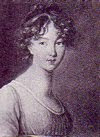
I am stitching.
Different things, often a reproduction. I am particularly fond of doing Irish/flame stitch items in the 18th century manner. All of the wool yarns used are naturally dyed ones from Kathleen B. Smith/Textile Reproductions (Massachusetts.) Some of the wool is about twenty years old, some was purchased in 2011.
Featured here is a needle book on 25 count linen, measuring 4 1/2" x 2 1/2" (flat.) This was a kit from Textile Reproductions, based on a piece in the collection of Historic Deerfield, Massachusetts, purchased and made many years ago. The interior is lined with a layer of fleece, covered by handwoven felted wool fabric which holds the needles.
The pincushion, also a kit from Textile Reproductions, from a past time, is worked in the elongated diamond or lozenge pattern on 25 count linen, measuring 4" x 4 1/2" , stuffed with fleece, and backed with handwoven silk fabric.

The hoop contains the body of a pinball of my own design on 28 count linen . The stitching is finished and currently measures 3" x 3"; the pinball will be smaller and will be backed with the same green silk used for the pincushion.
The frame holds two projects on 30 count linen. A needle roll of my own design worked in different version of a diamond pattern, measures 3" wide with a projected length of 12". The man's pocketbook on the left is another vintage kit from Textile Reproductions but I am not following the colour guide that came with it. There are evident errors in my stitching. I am also not happy with the background stitching around the initials. I will probably change the placement of the initials and add a date on the next pocketbook I make which will most likely be a smaller woman's one based on several in the collection of Winterthur Museum, Delaware, possibly in the carnation pattern. I am also have a double sectioned man's pocketbook, a woman's pocket, a Bible cover and a handheld firescreen on my to-do list.
I love working on this kind of project. The vivid dyes and their arrangement are such fun to reproduce or design. The research on and documentation of specific objects is is some of the easiest to do as there are so many surviving pieces in this kind of stitchwork from furniture to very small personal items. Best of all, it is another way to work with wool!


1 comment:
What a great blog! I'm also looking into historical stitching and knitting. I am a handspinner and my yarns are processed by hand as they would have been in the 18th century. Most of my dyes are natural from my garden with historical recipes.
www.bwwoolery.etsy.com
Post a Comment